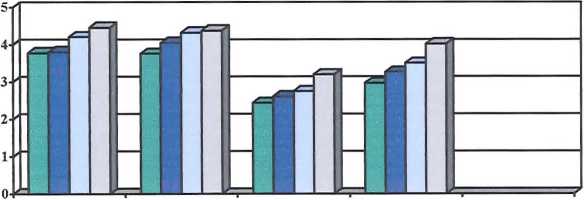126
Figure 4.2.5: Perceptions of pupils’ affective attitudes towards mathematics learning as
promoted by Individual work

Table 4.2.5: Perceptions of pupils’ affective attitudes towards mathematics learning as
promoted by Individual work
|
5lh grade teachers |
8lh grade teachers |
5lh graders |
8ttl graders__ | |||||||||
|
N |
Mean |
SD |
N____ |
Mean |
SD |
N____ |
Mean |
SD |
N____ |
Mean |
SD | |
|
Enjoyment________ |
48____ |
3.54 |
.74 |
42 |
3.52 |
.71 |
1479 |
2.92 |
1.32 |
2156 |
3.24 |
1.26 |
|
Motivation__________ |
48 |
3.69 |
.75 |
42 |
3.55 |
.63 |
1479 |
3.03 |
1.40 |
2148 |
3.33 |
1.29 |
|
Sense of security |
47 |
3.96 |
.72 |
40 |
3.93 |
.76 |
1474 |
3.17 |
1.39 |
2141 |
3.58 |
1.27 |
|
Sense of progress |
48____ |
4.15 |
.68 |
42____ |
4.14 |
.78 |
1476 |
3.46 |
1.34 |
2143 |
3.79 |
1.16 |
|
Repeated |
F(2,281,104.948)=11.339 |
F(2.520, 98.270)=10.078, |
F(2.929,4305.291)=93.754 |
F(2.853,6077.845), | ||||||||
|
Deployment_______ |
48____ |
4.50 |
.65 |
42_____ |
4.17 |
ππ |
1467 |
P-48 |
1.00 |
2134 |
3.84 |
.90 |
Individual help
There was a marked contrast between pupils’ and teachers’ responses. Teachers
believed that this promoted senses of security and progress much more than their
pupils, particularly the 5th graders. The effect was not so strong in relation to 8th graders.
Teachers of both age groups reported that the frequency of deployment of Individual
help was high. However, 8th graders reported the frequency moderate, and 5th graders
reported it as relatively low. This may explain why they perceived that it was not strong
in its effect on their attitudes to learning.
Figure 4.2.6: Perceptions of pupils’ affective attitudes towards mathematics learning as
promoted by Individual help

□ enjoyment
□ motivation
□ sense of security
□ sense of progress
I 5th grade teachers ∣ 8th grade teachers ∣ 5th graders ∣ 8th graders

More intriguing information
1. Prizes and Patents: Using Market Signals to Provide Incentives for Innovations2. The name is absent
3. AN EXPLORATION OF THE NEED FOR AND COST OF SELECTED TRADE FACILITATION MEASURES IN ASIA AND THE PACIFIC IN THE CONTEXT OF THE WTO NEGOTIATIONS
4. The name is absent
5. An Incentive System for Salmonella Control in the Pork Supply Chain
6. Perfect Regular Equilibrium
7. The name is absent
8. The economic doctrines in the wine trade and wine production sectors: the case of Bastiat and the Port wine sector: 1850-1908
9. The name is absent
10. The growing importance of risk in financial regulation